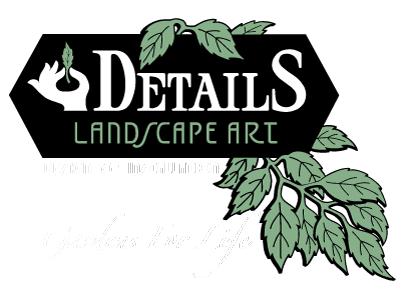When we design garden for a client, we consider many lifestyle factors in selecting trees and plants, such as: Will there be outdoor entertaining areas? How much maintenance is the client willing to undertake? Is there a need for year-round privacy? The answers to these questions will help us to determine if evergreen trees or conifers are appropriate.
Evergreen trees are messy all year long. While deciduous trees drop all their leaves all at once in the fall, evergreens and conifers drop their leaves and needles a little bit at a time all throughout the year. So if the proposed location of the tree is near a patio or other high use living area, a deciduous tree will be a better design element for the most of the entertaining season. Or if the owner doesn’t want to have to clean up dead leaves and needles all the time, then an evergreen won’t work. If the need for year-round privacy is a concern, these issues must be balanced – perhaps screening shrubs or an arbor will serve as a good screen. Generally speaking, where the property is large and there is lots of space away from the immediate living/entertaining area, evergreens or conifers are appropriate. There are several we like to use.
Evergreen trees:
Elaeocarpus decipiens (Japanese Blueberry) – perhaps our favorite smaller evergreen, it is relatively clean, pest free, and a rich dark green
Schinus molle (California pepper) – large, somewhat frost tender in Sonoma County (but bounces back). Resembles the habit of a weeping willow, but much more manageable
Mayten ‘Green Showers’ – resembles a weeping willow, but painfully slow growing

Podocarpus gracilior – needs some afternoon shade. Among the cleanest and most pest free of the evergreens.
Olea europaea (Olive) – There are fruiting and ‘non-fruiting’, but all are somewhat messy
Eriobotrya japonica (Japanese loquat) – beautiful, colorful, but VERY messy
Cinnamomum camphora (Camphor tree) – fragrance of camphor and quite large, growing slowly to fifty feet tall and sixty feet wide
Conifers:
Sequoia sempervirens (Redwood) – California native grows very tall, very fast and keeps going. Common varieties include Soquel, Aptos Blue, and Majestic Beauty

Cedrus dedara (Cedar) – beautiful drooping habit. Fast growing to 80 ft. Give it lots of room.
Picea pungens ‘glauca’ (Colorado blue spruce) – bluish-green needles, prefers dry, rocky soil. Lack of winter cold leads to aphids infestation.
Pinus thunbergii (Japanese Black Pine) – our favorite of the Pine family.
Ceanothus ‘Ray Hartman’ (Wild Lilac) – actually a fifteen ft. tall by fifteen ft. wide shrub that can be trained as a tree with a single trunk. Requires well drained soil.
Evergreens also tend to show less flowers, and certainly less seasonal color. Fall foliage occurs in deciduous trees before the leaves fall. A garden with too many deciduous plants and trees tends to look barren and lacking structure in the winter. A garden with too many evergreen plants and trees tends to look boring throughout the year, lacking spring blooms and autumn foliage. A well designed garden will have a nice mix of both evergreen and deciduous plantings.
